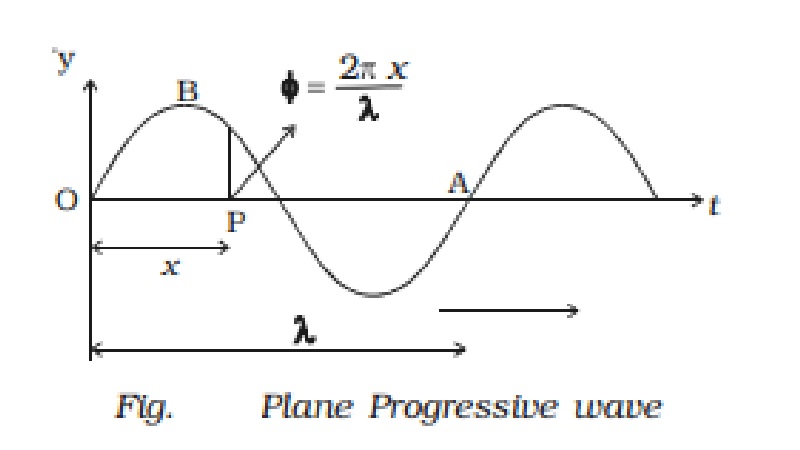Chapter: 11th 12th std standard Class Physics sciense Higher secondary school College Notes
Equation of a plane progressive wave

Progressive wave
A progressive wave is defined as the onward
transmission of the vibratory motion of a body in an elastic medium from one
particle to the successive particle.
Equation of a plane
progressive wave
An equation can be
formed to represent generally the displacement of a vibrating particle in a
medium through which a wave passes. Thus each particle of a progressive wave
executes simple harmonic motion of the same period and amplitude differing in
phase from each other.
Let
us assume that a progressive wave travels from the origin O along the positive
direction of X axis, from left to right (Fig. 7.6). The displacement of a
particle at a given instant is
y
= a sin ωt ... (1)
where a is the amplitude of the vibration of
the particle and ω = 2πn.
The displacement of
the particle P at a distance x from O
at a given instant is given by,
y = a sin (ωt - φ) ?.(2)
If the two particles
are separated by a distance λ, they will differ by
a phase of 2π. Therefore, the phase
φ of the particle P at a distance
x
is φ = 2π/λ . x
y
= a sin (ωt - 2πx/ λ)
Since
ω = 2πn = 2π v / λ, the equation is given by
y
= a sin(2πt/ λ - 2πx/ λ)
y
= a sin( 2π/ λ .(vt-x) ) ???..(4)
Since
ω = 2π/ T , the eqn. (3) can also be written as
y
= a sin 2π (t/T ? x/ λ)
If
the wave travels in opposite direction, the equation becomes.
y = a sin 2π(t/T + x/ λ) ???(6)
(i) Variation of phase
with time
The phase changes
continuously with time at a constant distance.
At a given distance x from O let φ and φ2 be the phase of a
particle at time t1 and t2 respectively.
φ1
= 2π(t1/T ? x/ λ)
φ2
= 2π(t2/T ? x/ λ)
φ2
- φ1 = 2π(t2/T
- t1/T)
∆φ
= 2π /T ∆t
(ii) Variation of
phase with distance
At a given time t
phase changes periodically with distance x.
Let φ1 and φ 2
be the phase of two
particles at distance
x1 and
x2 respectively from the origin at a time t.
φ1
= 2π(t/T ? x1/ λ)
φ2
= 2π(t/T ? x2/ λ)
φ2
- φ1 = 2π/ λ (x2 -
x1)
∆φ
= 2π / λ ∆t
The
negative sign indicates that the forward points lag in phase when the wave
travels from left to right.
When
∆x = λ, ∆φ = 2π, the phase difference
between two particles having a path difference λ is 2π.
Related Topics